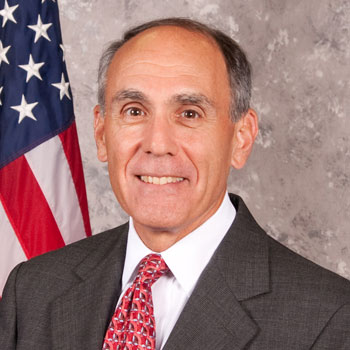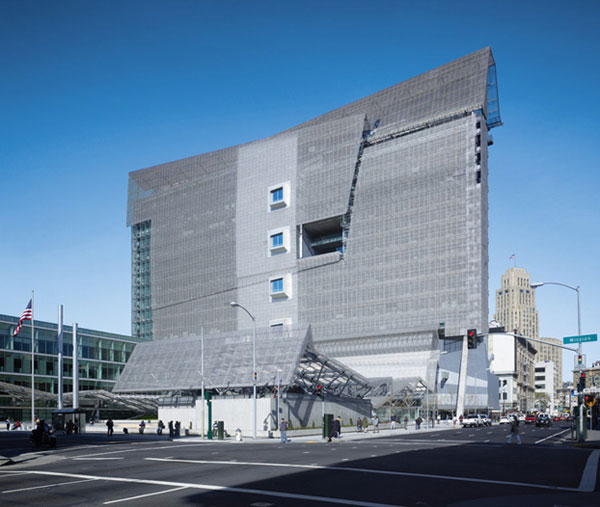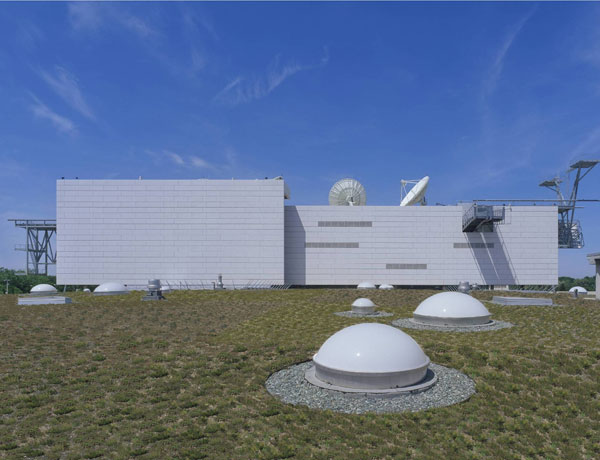News
Interview with Bob Peck, Honorary ASLA
 Image credit: GSA
Image credit: GSA
The U.S. General Services Administration (GSA) manages more than 370 million square feet of space for more than one million federal employees. Martha Johnson , GSA administrator, says a zero environmental footprint (ZEF) for all of GSA's half a million buildings will take a "moonshot, and require the GSA to innovate, take risks, and get out of our comfort zone." How is the GSA now taking risks in terms of green building and landscape design? How far has GSA progressed toward its ambitious environmental goals?
Actually, we just did a groundbreaking ceremony for the renovation of a historic federal building in Grand Junction, Colorado, which is going to be our first net zero building and apparently the first net zero project in a building that's on the National Register of Historic Places. We're pretty excited about that. To be candid, we have a lot of really good one-off examples of places where we've been innovative.
In 2000, we approved a design that's now up and running -- a federal building in San Francisco, California. The building isn't air conditioned. The question to ask yourself is why do they even have air-conditioned buildings in San Francisco at all? The windows open. It's a narrow floor plate. We've got great energy reductions in the building. We're trying to look at our comprehensive inventory and say, what can we do? There are small interventions in buildings where you're not doing major renovations. Huge interventions can be done in places where you're doing a complete redo like skinning the building and taking out all the old mechanics. What can we do to make those things work?
 San Francisco Federal Building, San Francisco, California. Architect: Morphosis; Dedicated: 2007. Tim Griffith/ESTO. GSA copyright prevents the reuse of these images. Please don't download.
San Francisco Federal Building, San Francisco, California. Architect: Morphosis; Dedicated: 2007. Tim Griffith/ESTO. GSA copyright prevents the reuse of these images. Please don't download.
 Proposal for Sustainable Sites Initiative Landscape, Pete V. Domenici Federal Courthouse, Albuquerque, New Mexico. Landscape Architect: Rios Clementi Hale Studios / Model, Rios Clementi Hale Studios. GSA copyright prevents the reuse of these images. Please don't download.
Proposal for Sustainable Sites Initiative Landscape, Pete V. Domenici Federal Courthouse, Albuquerque, New Mexico. Landscape Architect: Rios Clementi Hale Studios / Model, Rios Clementi Hale Studios. GSA copyright prevents the reuse of these images. Please don't download.
The other thing we're trying to do is to be a green proving ground for the whole building industry because, after all, we're taking your dollars and investing them in our buildings.We think for some part of what we're doing we can beta-test new technologies and practices, see if they work, and report out to the whole design and construction industry on what's really working. I think there's a hunger out there for this. Everybody is talking green and a lot of people are trying to figure out what can I do, what works, what's the best bang for the buck if I'm a private investor, and so we're anxious to do that too.
A near term goal issued by the President calls for reducing federal greenhouse gas emissions by 28% by 2020. This is equal to 250 million barrels of oil or taking 17 million cars off the road for one year. What role do landscapes play in the GSA's energy efficiency and greenhouse gas emission reduction goals?
We all know that we have developed in some of our formal landscapes unsustainable landscapes. Landscapes that require a lot of maintenance. It could be the truck that has to drive in and put down certain kinds of chemicals, which we don't like either. In the old days, that was what was needed to make landscapes work. Your profession knows better than anyone how you can design or plant a landscape that is appropriate to the climate, that's low maintenance, and obviously we want to take advantage of that as much as we can.
The second side is what landscapes can contribute to a building. That's everything from recycling greywater to including ponds that manage stormwater runoff and filter out pollutants. This enables us to reduce runoff from impervious surfaces. Then, there are obviously green roofs that we're also using as much as we can.
GSA has been an early adopter on sustainable landscapes. Now three very different landscape projects in New Mexico, Florida, and Washington, D.C., are Sustainable Sites Initiative (SITES) pilot projects. What is GSA hoping to accomplish by participating in the pilot phase of this new rating system? Just as the GSA requires new buildings to meet LEED gold levels of certification, do you foresee GSA requiring landscapes to achieve higher levels of SITES for all government landscapes?
We just kicked our new building construction standard up from LEED silver to LEED gold. We're serious about environmental stuff. You know how they say in business, you get what you measure? If we don't measure the landscape side of what we're doing, we'll do some nice things here and there but that's it. We want to make sure they are actually as sustainable as they can be. I don't think it'll be a terribly long time, if we can have any confidence in the rating system. We're prepared to test the rating systems and see what really pans out. It's clearly something we'd like to do soon and work with the profession to make happen.
In terms of managing stormwater, green infrastructure can be defined as man-made systems that mimic natural functions. Green roofs, bioswales, bioretention ponds, permeable pavements and all ways to turn hard asphalt surfaces into green ones. Does GSA see green infrastructure as a workable solution for its sites? Have you seen any data or analysis within the government on the costs and benefits of green infrastructure?
I haven't seen any good numbers on the costs and benefits, and, unfortunately, I think you can say that in general about a lot of green design. We're still in that phase in part because these landscapes are long-term things. You can measure car emissions pretty fast and project them. In our business, it takes a little bit longer so I haven't seen the numbers but we're certainly trying to do everything we can on the green infrastructure side.
We have a lot to learn from people in the past who didn't know they were doing green, who didn't have the opportunity to "mechanize" the landscape and the buildings. Green infrastructure uses the land to filter runoff. I hate to say this but I didn't know land did that until I was many years in to my career and people started making that point. I thought once you were in a city or a civilized area you always had to build a sewer system that took all of that for you. So, I think we're all sort of feeling our way in to it but we're sure interested in getting there and using the natural landscape and natural materials as much as we can. Substituting the hard materials that would have to be manufactured is another big benefit.
GSA installed its first green roof in 1975. Now there are more than one million square feet of green roofs across all federal government buildings. A roof on the building of the National Oceanic and Atmospheric Administration (NOAA) is more than 100,000 square feet alone. This is an achievement, but in terms of all GSA's buildings a drop in the ocean. To spur the growth of green roofs has GSA been providing incentives to organizations? Is there a bigger goal for green roofs?
Instead of being prescriptive, we're trying to be performance oriented. We're saying to people, we'll at least consider any idea you bring to us that will reduce the energy and resource use in our buildings and lower our carbon footprint. Those government green roofs are not a result of our design people telling somebody to do it. It's somebody else coming in and saying, the only way I'm going to meet your standard, the only way we're going to get to either a LEED rating or your energy reduction standard, is if I give you the following things and one of them will be a green roof.
 Green Roof, NOAA Satellite Control Center, Suitland, Maryland. Architect: Morphosis; Dedicated: 2005 / GSA. GSA copyright prevents the reuse of these images. Please don't download.
Green Roof, NOAA Satellite Control Center, Suitland, Maryland. Architect: Morphosis; Dedicated: 2005 / GSA. GSA copyright prevents the reuse of these images. Please don't download.
It's quite conceivable that at some point we get to a point where we've measured enough that we can. I'll give you an example from the mechanical side of things. We know there area areas where you're going to say, don't even talk to us about a wind turbine. There's no wind, In other places we say, photovoltaics don't work so well in this area. We may end up in the same business where we say, this doesn't seem to be a terribly good place to try a green roof but we try other things. That's a possibility.
Does GSA see itself as a model for commercial green building and landscape practices? If so, are there any examples of organizations or developers that have taken up a GSA best practice?
We are talking about ourselves as a green proving ground. We want to try not only the things that everybody knows about like a green roof or photovoltaics, but actively solicit ideas for technologies and practices that haven't been tried in real-life application. We're describing it as beta-testing the next generation of green technologies. I can't say what new technologies yet because we have a solicitation that just closed in which we asked people to give us their ideas. We haven't selected the ones we're going to go with but we're actually going to put some money into a couple of these things and see what works.
I'm not sure that yet I could cite anything where we have done what you described, which is actually my dream. I hope we find something that really works well, gets adopted by industry, and then a couple things could happen that the Obama administration loves to talk about: we will create jobs for people in green technology and infrastructure. If somebody has an idea that they invented in a garage, we take it, and it becomes a big standard practice that would be a big win for us.
In the past government buildings have sometimes been sited without community input. In addition, many buildings often feature high levels of security. What steps is the GSA taking to design buildings and landscapes with the input of existing communities? Are government buildings now being designed to spur community revitalization?
We hope so. There is usually a good deal of community input on where to place government buildings. It depends on how you define community input. Sometimes it's local elected officials who tell us where they would like us to locate a project. Often, it's in an area where they're hoping to spur economic development. That puts an obligation on us to design a facility in a way that actually does spur economic development. Going back to the new federal building in San Francisco. First of all, there's a McDonald's in a building we built on that site, on the corner. That's a small aspect of community development but it was a vacant lot. The area has become a pretty hot area for development in San Francisco. It's not so far from the Museum of Modern Art.
We have a number of issues that landscape architects can help us with.We are a public investment on whatever site we build on or wherever we renovate. It's the community's tax dollars. It shouldn't just be a nice building for the federal employees who work there or even for people who visit. It ought to do something more. We also have a lot of security requirements these days that often work against the whole goal of being open, inviting, and creating an atmosphere of vitality around the building. If you build a building that looks and works like a fortress, that site could be a dead hand right in the middle of commercial and residential activity. We need some help on the default design responses to security. We have not tapped into the creativity of the design professions. For example, people always putting bollards around a site. We know trees of a certain caliber are as sturdy as a bollard so we can at least substitute some trees for bollards. In some cases, we've done that. It's still not clear that we need to ring our buildings with bollards because we can get the security enhancements we need in other ways.
Finally, our sites need to be more welcoming, which will help create a better community around them. We really don't need formal landscape designs that are not attractive to people. We need formal landscape design that's sustainable and makes people want to be there. More parks and less empty plazas. That's what we strive for.
Bob Peck, Honorary ASLA, is Commissioner of Public Buildings for the U.S. General Services Administration.
Interview conducted by Jared Green.